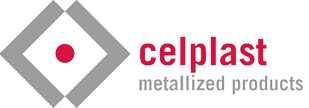There are many packaging applications where a consumer packaged goods (CPGs) company would like the brightness and some of the barrier properties offered by metallized film, but with clear segments where the customer can see the product too. This is particularly true of fresh foods or produce, where the ability to see the actual product in the package is a necessity. As consumers become more demanding, and CPGs have to fight for shelf space, this is a more and more common request from the marketplace.
A cost effective way to produce such a package, with both metallized and clear sections, is by using a metallized web that has clear stripes in the machine direction. This way, depending on how the pre-made pouch is made, or whether the laminated web runs on FFS equipment, the clear stripe can be oriented in the horizontal or vertical direction on the pouch.
There are three basic technologies available to carry out one-pass stripe metallizing. The first is using chill roll banding, where metal bands lay on the film as it passes over the chill drum in a drum metallizer. The bands peel off the film after it passes through the metallizing area, leaving clear stripes behind. These bands need to be cut to width, with significant set-up involved to properly align them. There is also differential heating of the film on the chill roll, since the metallized portion of the film is much hotter than the clear section directly adjacent to it. This leads to pucker lanes and wrinkling, particularly for heat sensitive films like BOPP, CPP or LDPE. This technology is no longer in use in North America, and is in very limited use in other parts of the world.
The second, and most common, technology is oil masking. This is done by applying a food-grade oil in a steady stream onto the film in defined segmented widths and spacing as machine-direction oil strips on the film. This can be done using an engraved roller passing through an oil bath, or with nozzles. When the oil strips enter the metallizing zone, the oil is (for the most part) flash evaporated by the aluminum vapour and the heat of the metallizing process. The film areas with oil remain unmetallized, while the film areas without oil are metallized. This process can give excellent edge definition, with a sharply defined edge between the metallized and clear stripes. The downside, of course, is there is always a small amount of residual oil left on the film surface in the clear striped portion of the web after this process. This can impact downstream printing and laminating processes. This is the most common technique used for stripe metallizing in the industry today.
The third technology is free span masking. This is where a physical mask, supported in the metallizing area, lies just below the film path. While similar to chill roll banding, a key difference is the metallizing is carried out in the free span area, prior to the chill roll. This creates less differential heating on the clear & metallized portions of the film, so pucker lanes are not an issue, even with heat sensitive films.
One obvious limitation created by stripe metallizing is the barrier functionality of the metallizing process is greatly reduced when a portion of the film is not actually being metallized. This can be overcome by starting with a clear barrier film, such as AlOx-coated PET, and applying the stripe metallizing process on top of the AlOx layer. This way, the high barrier properties can be maintained, along with the clear & metallized effects that are desired by the CPG. For more on this, stripe metallizing on AlOx-coated PET was discussed in this former article: http://www.celplast.com/new-announcement/stripe-metallized-barrier-alox-pouch/.
Searching for customized packaging solutions? Contact us for any questions or packaging challenges you are looking to solve.
-Naomi
naomi@celplast.com
Naomi Panagapka
Customer Solutions
Celplast Metallized Products
Providing the industry’s best customer service


